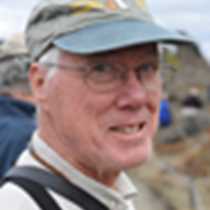West Spitsbergen, Svalbard
Driftwood. I was going to take that as my theme for the day: driftwood on the beaches of Svalbard and the stories that it tells. We had landed on a gravel beach on Prins Karl's Foreland, a long, thin island off of the west coast of Spitsbergen, the largest island of the Svalbard Archipelago. We found the beach there littered with driftwood of various origins and antiquity (and an occasional old plastic ketchup bottle). Much, even most, of it has somehow been worked by the hand of man. Each piece has a story to tell if only we listen. But then there were the walrus, and later both fin and blue whales. Let me think ... what will our guests most want to remember of this day? Is it driftwood, or walrus, or whales? The Naturalist ponders.
Walrus: in size they are second only to elephant seals (which many of us have seen in California and in Antarctica) among the pinnipeds - the seals and their allies. Walrus lying in a heap on the beach at Poolepynten. Walrus too close together to count, each in contact with (and sometimes lying on top of) its many neighbors. Is it a herd of walrus? A heap? A pile? We searched for the appropriate collective. (This writer prefers the collective term "buncha" for such an assemblage, as in "a buncha walrus.") Poolepynten is regularly used by male walrus while females with their young assemble elsewhere. We approached slowly, with great caution to avoid spooking the animals, and they were quite content to ignore us.
Occasionally the walrus stirred and rose up, showing us their long, white tusks which are grossly exaggerated canine teeth. Their tusks continue to grow throughout life, but we could see that some tusks had been broken off, most likely in conflicts between bulls as they fought for the rights to females during the breeding season. Sluggish, almost inert on land, the walrus are amazingly graceful and agile in the water, even while remaining in close contact with their fellows. A group of five swam close to the ship to show off their aquatic acrobatics.
For the afternoon we headed out to sea off the west coast of Spitsbergen, to the break where the Continental Shelf drops off into the deep ocean. There, oceanic currents are diverted upward, bringing nutrient-rich water up to the surface. Nutrients from the deep plus light at the surface gives oceanic productivity. Tiny planktonic algae - diatoms - are grazed by copepods. These are consumed by larger zooplankton and small fish, and voilá, we have an abundance of food for the biggest of marine life, the biggest of all life, ever, the great whales.
Observers on the bridge were very happy (as much as they might deny it) to interrupt the presentation on Arctic exploration history to announce their sighting of massive fin whales and ... could it really be? ... even more massive blue whales. Fin whales do not throw their tail flukes into the air as they dive to the depths, but one of these whales was definitely doing so. A closer approach revealed the mottled, blue-gray side of the huge blue whale. Once hunted to near extinction, there is reason to think that their population is showing some sign of a gradual recovery (enough hedge-words there?). We can only rejoice in our encounter and hope for the future.
Exploration history? We can defer that until after dinner. Driftwood will just have to wait for another day.
And yes, Michael DID get it.




